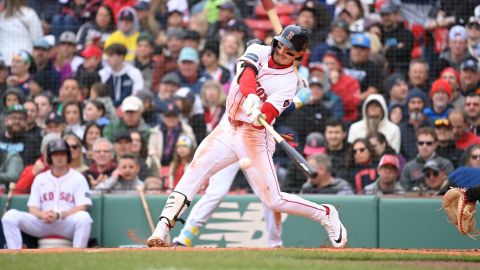 Editor’s note: Michael Narracci is the coordinating director of Red Sox broadcasts on NESN and has spent 14 seasons with the network. This is the 10th installment of his “Director’s Cut,” a behind-the-scenes look at NESN’s Red Sox game coverage.
Editor’s note: Michael Narracci is the coordinating director of Red Sox broadcasts on NESN and has spent 14 seasons with the network. This is the 10th installment of his “Director’s Cut,” a behind-the-scenes look at NESN’s Red Sox game coverage.
Moving the Red Sox traveling party around during a baseball season is like a well-choreographed ballet, orchestrated by a bunch of dedicated professionals.
A road trip starts on the last day of a homestand when players and personnel arrive at Fenway Park. The man in charge of orchestrating this ballet is Red Sox traveling secretary Jack McCormick. He’s responsible for, among other things, booking aircraft, hotel reservations, buses, distributing expense money and any other miscellaneous tasks that revolve around the team travel. Jack also reserves accommodations for the entire organization in Fort Myers for the entirety of spring training. This is a big job with a lot of moving parts all complicated by uncontrollable variables such as long or extra-inning games, new players, traffic, weather, mechanical difficulties — you name it.
On a travel day, Joe Silva, Mike Chester and Pauly Anderson greet the travel party members at Fenway Park. They are responsible for the care of personal vehicles at Fenway Park during the road trip. This is a stressful job, compounded by the fact that they are moving very expensive automobiles in a very congested area. Imagine the movement of aircraft around the flight deck of an aircraft carrier.
The next step is the bag drop. For security reasons, everyone has identical bags that are tagged with an identifying luggage tag. Clubhouse attendant Jared Pinkos builds a manifest of bags that are dropped off, so as the party moves from city to city, the same number of bags that arrive in a city, leave from the city. No bag is left behind.
Everyone then goes about their business of getting ready for the game or broadcast.
At the conclusion of the game, it’s go time.
On the NESN broadcast side, we pack all of our archival video drives, miscellaneous video tapes, microphone flags, scorecards, music disks and an assortment of other odds and ends into a travel case. Our transmission encoder, which takes a very large bandwidth HD signal and makes it manageable for transmission over the nation’s fiber optic network, is moved to the staging area earlier in the day, as we do not use it at Fenway. The portable score box, which displays all the pertinent information about the broadcast such as score, inning count, etc., also is moved earlier.
On the baseball operations side of things, bats, balls, gloves, uniforms, hats, medical equipment and video equipment are packed in their respective areas and are readied to be loaded onto the equipment truck for transport to the airport and the waiting aircraft. The army of clubhouse personnel (or “clubbies”) then starts moving all of the cases and bags to the equipment truck. The clubbies, led by Tommy McLaughlin and Pookie Jackson, include Steve “Murph” Murphy, Jared Pinkos, Chris “Cundy” Cundiff, Kenyata Gomez, Dean Lewis, Luke Antsy and Gary Rich. They have a really unenviable job. There is a lot of stuff in big, bulky and heavy cases, but they always have a smile on their faces.
As the equipment is being loaded, traveling personnel undergo a thorough screening by TSA-sanctioned personnel, including bag search and metal detectors. This is no different than what commercial travelers endure at an airport with the exception that the lines are a bit shorter as the traveling party trickles through in small groups. Once the screening is complete, travelers board one of two buses. Staff and media are on one bus, and players are on the other. When all are aboard, our convoy makes its way to Boston’s Logan Airport through postgame traffic.
After entering the airport, our convoy is escorted by state police and airport vehicles to the awaiting charter aircraft. Buses empty, and everyone boards — bus No. 1 through the forward door, bus No. 2 through the rear. Our flight attendants — Meaghan, Lori, Glennis, Courtney, Dustin, Laurie and others — are onboard and work hard to get snacks and drinks served, suit jackets hung and menus distributed before take-off. These ladies and gentleman are awesome and make the travel so much easier.
The aircraft usually is a standard 757, with three seats on each side of the aisle. Coaches are in first class, media and staff in what I refer to as the DMZ (behind first class and stretching to the exit rows) and players in the rear. Jerry Remy has had the same seat for 20-plus years: first row, DMZ, driver’s side. He’s followed by Joe Castiglione, Dave O’Brien and staff. Don Orsillo is in the first exit row with Jim Daddona, while I take the first row behind the snacks. The sideline reporter usually is my travel buddy, unless I am sitting with my wife, Sarah, who is the Red Sox’s director of community and player relations.
While this is happening, baggage handlers are transferring all the suitcases, garment bags and equipment cases from the equipment truck into the cargo hold of the aircraft under the watchful eye of clubhouse manager Tommy McLaughlin. This takes some time because of the large volume of equipment. When the loading is complete, doors are closed, and we are on our way.
In flight, people pass the time differently. Don and Jerry review game notes for the team the Red Sox are playing next. Others read, watch movies or get some sleep. It’s pretty quiet and subdued — not what I expected when I started this job 14 seasons ago.
When we land, two buses and two box trucks are waiting on the tarmac for us. Coaches, staff and media board bus No. 1, and players get on bus No. 2. One box truck is loaded with luggage and sent to the hotel, while the second truck is loaded with baseball, television and radio gear for transport to the ballpark.
While every effort is made to make the travel a pleasant experience, it’s still tough. Late-night departures, early morning arrivals and the occasional aircraft mechanical trouble all contribute to the grind. The last road trip (St. Louis, Anaheim, Cincinnati) was one of the toughest I can remember in my 14 seasons, as is the Toronto-Tampa-New York trip. We still have another three-city trip this year. Time zone changes, rain delays and extra innings all contributed to the grind of life on the road.



